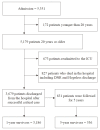Long-term mortality of patients discharged from the hospital after successful critical care in the ICU in Korea: a retrospective observational study in a single tertiary care teaching hospital
- PMID: 31220909
- PMCID: PMC7113159
- DOI: 10.4097/kja.d.18.00275
Long-term mortality of patients discharged from the hospital after successful critical care in the ICU in Korea: a retrospective observational study in a single tertiary care teaching hospital
Abstract
Background: The long-term outcomes of patients discharged from the hospital after successful care in intensive care unit (ICU) are not briskly evaluated in Korea. The aim of this study was to assess long-term mortality of patients treated in the ICU and discharged alive from the hospital and to identify predictive factors of mortality.
Methods: In 3,679 adult patients discharged alive from the hospital after ICU care between 2006 and 2011, the 1-year mortality rate (primary outcome measure) was investigated. Various factors were entered into multivariate analysis to identify independent factors of 1-year mortality, including sex, age, severity of illness (APACHE II score), mechanical ventilation, malignancy, readmission, type of admission (emergency, elective surgery, and medical), and diagnostic category (trauma and non-trauma).
Results: The 1-year mortality rate was 13.4%. Risk factors that were associated with 1-year mortality included age (hazard ratio: 1.03 [95% CI, 1.02-1.04], P < 0.001), APACHE II score (1.03 [1.01-1.04], P < 0.001), mechanical ventilation (1.96 [1.60-2.41], P < 0.001), malignancy (2.31 [1.82-2.94], P < 0.001), readmission (1.65 [1.31-2.07], P < 0.001), emergency surgery (1.66 [1.18-2.34], P = 0.003), ICU admission due to medical causes (4.66 [3.68-5.91], P < 0.001), and non-traumatic diagnostic category (6.04 [1.50-24.38], P = 0.012).
Conclusions: The 1-year mortality rate was 13.4%. Old age, high APACHE II score, mechanical ventilation, malignancy, readmission, emergency surgery, ICU admission due to medical causes, and non-traumatic diagnostic category except metabolic/endocrinologic category were associated with 1-year mortality.
Keywords: Critical care outcomes; Intensive care unit; Long-term outcomes; Mortality; Risk factors; Survival analysis.
Conflict of interest statement
No potential conflict of interest relevant to this article was reported.
Figures


Comment in
-
In response to Na et al.'s long-term mortality of patients discharged from the hospital after successful critical care: do we need more comprehensive data?Korean J Anesthesiol. 2020 Apr;73(2):171-172. doi: 10.4097/kja.19366. Epub 2019 Sep 26. Korean J Anesthesiol. 2020. PMID: 31556258 Free PMC article. No abstract available.
Similar articles
-
Assessment of the Safety of Discharging Select Patients Directly Home From the Intensive Care Unit: A Multicenter Population-Based Cohort Study.JAMA Intern Med. 2018 Oct 1;178(10):1390-1399. doi: 10.1001/jamainternmed.2018.3675. JAMA Intern Med. 2018. PMID: 30128550 Free PMC article.
-
Three-year outcomes for Medicare beneficiaries who survive intensive care.JAMA. 2010 Mar 3;303(9):849-56. doi: 10.1001/jama.2010.216. JAMA. 2010. PMID: 20197531
-
Long-term treated intensive care patients outcomes: the one-year mortality rate, quality of life, health care use and long-term complications as reported by general practitioners.BMC Anesthesiol. 2015 Oct 12;15:142. doi: 10.1186/s12871-015-0121-x. BMC Anesthesiol. 2015. PMID: 26459381 Free PMC article.
-
Outcomes and prognostic factors in patients with haematological malignancy admitted to a specialist cancer intensive care unit: a 5 yr study.Br J Anaesth. 2012 Mar;108(3):452-9. doi: 10.1093/bja/aer449. Epub 2012 Jan 31. Br J Anaesth. 2012. PMID: 22298243 Review.
-
Fever management in intensive care patients with infections.Crit Care. 2014 Mar 18;18(2):206. doi: 10.1186/cc13773. Crit Care. 2014. PMID: 25029624 Free PMC article. Review.
Cited by
-
Temporal trend of tracheostomy in patients hospitalized in the Brazilian National Unified Health System from 2011 to 2020.Rev Col Bras Cir. 2022 Sep 2;49:e20223373. doi: 10.1590/0100-6991e-20223373-en. eCollection 2022. Rev Col Bras Cir. 2022. PMID: 36074394 Free PMC article.
-
In response to Na et al.'s long-term mortality of patients discharged from the hospital after successful critical care: do we need more comprehensive data?Korean J Anesthesiol. 2020 Apr;73(2):171-172. doi: 10.4097/kja.19366. Epub 2019 Sep 26. Korean J Anesthesiol. 2020. PMID: 31556258 Free PMC article. No abstract available.
-
Transparency considerations for describing statistical analyses in research.Korean J Anesthesiol. 2021 Dec;74(6):488-495. doi: 10.4097/kja.21203. Epub 2021 Nov 17. Korean J Anesthesiol. 2021. PMID: 34784456 Free PMC article.
-
Long-term outcomes and associated factors among intensive care unit survivors in a low-income country: a multicenter prospective cohort study.BMC Res Notes. 2024 Aug 1;17(1):215. doi: 10.1186/s13104-024-06874-w. BMC Res Notes. 2024. PMID: 39090677 Free PMC article.
References
-
- Health Insurance Review Agency . Seoul: ICU benefits appropriateness evaluation report. HIRA e-Book [Internet] 2004 Dec [cited 2018 Sep 17]. Available from: https://www.hira.or.kr/sViewer/index.do?ebookSn=418.
-
- Angus DC, Carlet J, Brussels Roundtable P. Surviving intensive care: a report from the 2002 Brussels roundtable. Intensive Care Med. 2003;29:368–77. - PubMed
-
- Dowdy DW, Needham DM, Mendez-Tellez PA, Herridge MS, Pronovost PJ. Studying outcomes of intensive care unit survivors: the role of the cohort study. Intensive Care Med. 2005;31:914–21. - PubMed
Publication types
MeSH terms
LinkOut - more resources
Full Text Sources
Medical

